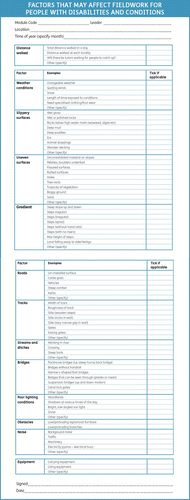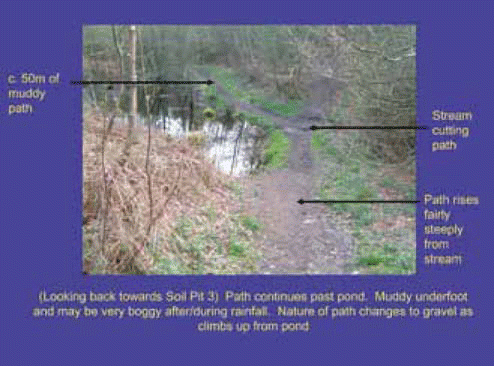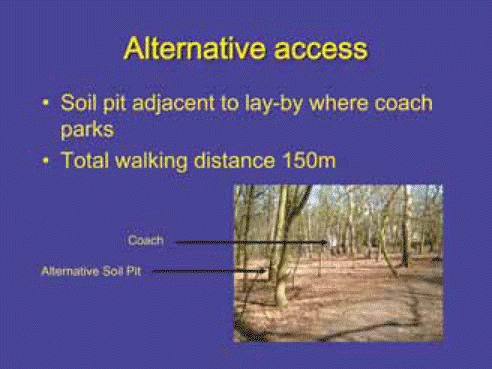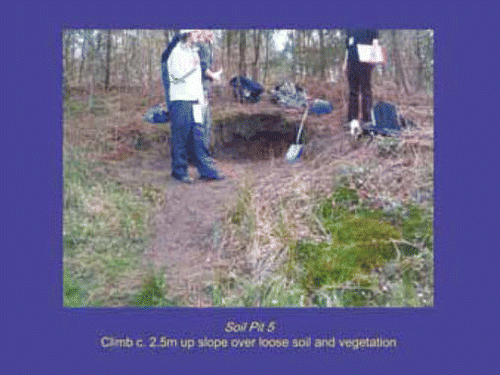Abstract
Fieldwork is regarded as an integral component of geoscience and related curricula in most higher education institutions (HEIs). It offers undergraduates opportunities to apply their learning in diverse environments whilst also developing skills valued by employers. However, it is recognized that field activities may present barriers to disabled students thus, potentially, limiting opportunities available to them. Legislation requires that staff in HEIs anticipate disabled learners' needs, but this can be difficult and time-consuming, especially with regard to fieldwork. The aims of this paper are to present an audit tool that may be used to anticipate barriers that particular field locations or activities may present and report on a simple, yet effective, approach that will assist staff planning field-based activities.
Introduction
Fieldwork is regarded as an integral component of geoscience and related curricula in most higher education institutions (CitationHall et al., 2002). This view is endorsed by the benchmark statement for the earth sciences, environmental sciences and environmental studies which states that:
“… it is impossible for students to develop a satisfactory understanding… without a significant exposure to field-based teaching and the related assessment”
Such ‘significant exposure’ may encompass day visits to various sites, residential fieldwork and field expeditions. Similarly, diverse assessment modes may be employed to assess student learning in such contexts e.g. field notebooks, field reports, stratigraphic logs, mapping, etc. Field work is covered by Part 4 of the Disability Discrimination Act (2002) so staff organising such learning activities need to anticipate the requirements of disabled students (CitationDRC, 2007) and ensure that student engagement with assessed activities is not compromised. Section 3 (Disabled Students) of the Quality Assurance Agency (QAA) Code of practice for the assurance of academic quality and standards in higher education (1999) is currently being revised. Two statements in the current code are pertinent to the provision of accessible field-based learning opportunities:
“Emphasis is placed in the legislation on the need for an institution to anticipate the needs of disabled students… Accordingly, institutions are expected to include the needs of disabled students in their planning.”
“Both the design and implementation of the learning and teaching strategies and activities should recognise the entitlement of disabled students to participate in all activities provided as part of their programme of study.”
Thus, in line with the Code of Practice, there is a requirement for fieldwork providers in HEIs to (a) anticipate the needs of disabled students when planning field-based activities; and (b) to recognise that disabled students have an entitlement to participate in fieldwork when it is a critical element of their programme of study.
Many reports published within the last decade have provided guidance for teachers in higher education to enable them to develop curricula that are inclusive and accessible (CitationDoyle and Robson, 2002; CitationSWANDS, 2002; CitationCADISE, 2003; CitationNDT, 2005). The Geography Discipline Network produced a series of guides addressing issues related to fieldwork provision for students with different disabilities (CitationBirnie and Grant, 2001; CitationChalkley and Waterfield, 2001; CitationGardiner and Anwar, 2001; CitationHealey et al, 2001; CitationShepherd, 2001; CitationWareham et al., 2001). These and other guides recommend the auditing of curricula to identify potential barriers to learning. The aim of this paper is to present an audit tool that may be used to anticipate barriers that particular field locations or activities may present.
Disability support in natural sciences and psychology
The School of Natural Sciences and Psychology has approximately 50-60 disabled students (i.e. 8–10% of the total cohort) in any one academic year. These students disclose disabilities across a wide spectrum, but have included students with visual, mobility and manual dexterity impairments, and fatigue-related illnesses. As part of the provision for these students, in line with SENDA 2001 compliance, the former School of Biological and Earth Sciences (now the School of Natural Sciences and Psychology) at Liverpool John Moores University (LJMU) pioneered a Disability Support Group (DSG) which has been active since 2002. The staff-based group (comprising a lecturer who is the School's Disability Co-ordinator, a research officer, an IT support technician and two technical managers) was established to provide a subject-specific focus for expertise and information dissemination to staff regarding disability support for students. The group ensures that disabled students have ready access to School staff who they can approach in cases of difficulty. An administrator is a co-opted member of the group and can advise on any examination-related issues. The DSG reviewed different components of programme curricula and identified a need for an overview of field activities and locations to gain insight into their inclusivity and accessibility.
When disabled students enquire about degree courses at LJMU they frequently ask about the fieldwork content, location and what visits may entail. Their perception of barriers that such learning opportunities could present may influence their choice of university, especially if they are not used to working outdoors. This was recognised some years ago when CitationHall et al. (2002) concluded that
“… fieldwork acts in a number of ways as a barrier to participation of some disabled students in geography, earth and environmental sciences and this suggests that disabled students might not choose these subjects in the first instance because of their fieldtrip requirements.”
One way of tackling this genuine concern for some students is to demonstrate exactly what the field visit entails in terms of physical locality and work involved. Thus, it became clear that an audit of fieldwork activities could provide a valuable tool to focus attention on the inclusivity of current fieldwork provision and enable colleagues to identify potential barriers that their fieldwork activities may present.
Disabled students are encouraged to contact the Disability Co-ordinator prior to accepting an offer of a university place or enrolling on a course to discuss the content of modules and, specifically, any fieldwork issues that may arise. Examples where this approach has proved particularly successful have included a blind student and a student with lower limb amputation. The process of working through the audit in dialogue with the student enables the Disability Co-ordinator to anticipate any barriers that fieldwork activities may present. It also allows the students to comprehend the nature of the field work environment.
Precursors to the audit
The potential audit approach was discussed initially by the DSG in November 2004. Following this, we researched and designed a questionnaire to identify factors that may affect fieldwork for people with disabilities and especially those impacting on mobility and fatigue (). The questionnaire was designed to be quick and easy to use and was based on a checklist approach. It was distributed to all staff and had the beneficial effect of encouraging academic staff to reflect carefully on the locations they visit on fieldwork. The questionnaire outlined a range of potential barriers that staff may not identify when first planning fieldwork activities (e.g. noise in a quarry or walking next to running water may affect the concentration of a person with hearing difficulties) and required fieldwork leaders to tick those relevant to their field contexts. However, this approach, although useful for identifying barriers, had severe limitations as it did not provide the sufficiently high level of site specific detail required for audit purposes. It was also felt that the questionnaire layout would not provide comprehensive information to staff and students who were unfamiliar with the field localities.
Alongside the work on the fieldwork audit, the School has had great success with the design and use of virtual fieldwork programmes (CitationMilsom et al., 2002, CitationStott et al., 2006, CitationStott et al., 2009). Such programmes have been identified as both valid learning opportunities and tools to provide access to ‘the field’ where the environment presents barriers to disabled students (CitationFletcher et al., 2002). These resources were developed, initially, as a replacement during the foot and mouth disease crisis in 2001. Such computer-based resources are immensely time consuming to produce and are not suitable for every field visit. On the other hand, they do allow ‘access’ to sites that some people may not physically be able to visit. It was felt that a fieldwork audit tool needed to provide a compromise between the two extremes (i.e. nothing or a virtual fieldwork programme) which was easier to produce. Consequently an audit based on a Powerpoint presentation was chosen as the most accessible and versatile format because it can be easily updated and most people are able to use the programme without special training. The audit files could then be made available to all students on the module through Blackboard, the University's Virtual Learning Environment.
The audit was a pilot study, focusing on geoscience modules, to assess the feasibility of the approach before applying to all modules across the School. Funding was secured from the University's Teaching Quality Enhancement Fund. Once the concept and style of a fieldwork audit was accepted by the DSG, students with disabilities (particularly those with mobility, dexterity, hearing and visual impairments) were asked what they recommended for incorporation into such an audit. The main categories of the audit are shown in .
Table 2 The main categories within the audit and examples of what they may cover.
Audit operation
Since 2005, a member of the DSG has attended one-day field-based activities for all geoscience modules selected to test and complete the audit. The presence of this independent observer in the field was felt necessary not only because staff leading the fieldwork would have insufficient time to complete the audit, but also because the observer could apply a more detached and objective approach to the task. In addition, having the same person performing all the audits provided consistency during the trial period. Activities and locations were photographed and key features detailed (see ). There is a rolling programme for completing and updating the geoscience audits as modules and field localities change over time. It is envisaged that more subject-specific staff will be trained to complete biological and environmental science audits.
As stated earlier, the fieldwork audit can be made available to students and the module teaching team through Blackboard in the form of a Powerpoint slide show. This gives all students a ‘feel’ for what the fieldwork involves in advance. It also provides the teaching team with the opportunity to track student access to the audit. This facilitates identification of those students accessing the information and evaluation of the ratio between disabled and non-disabled users. Any access by non-disabled users could be construed as acting as raising awareness of disability issues.
Strengths of the audit approach
The audit has helped raise teaching staff awareness of the very real issues related to disability that some students face when on fieldwork, such as their ability to transport and use specialist equipment.
It has also shown staff that, rather than disability being an insurmountable obstacle, there are solutions to any situation by utilizing lateral thinking. For example, access to a site may be feasible if there is a different route, or it may be possible to identify an alternative, more accessible site where the same learning outcomes can be achieved.
The audit can and has been used to reassess the core fieldwork activities (observational skills; recording skills, intellectual skills) and how student learning is achieved and evidenced. The process allows staff the opportunity to anticipate alternative, appropriate modes of assessment to accommodate disabled learners where necessary.
All these strengths help to give staff the awareness and confidence to fulfil the requirements of the legislation concerned with disability and inclusivity.
Disabled students have felt that the information contained within the audit (especially the images) have enabled them to formulate strategies to anticipate and overcome possible barriers presented by the fieldwork or, after discussion with the academic staff, decide on a mutually agreeable alternative. An example of this occurred when health and safety requirements prevented a blind student from participating in a Level 3 residential field course. Consequently, two tactile models were built to represent part of the field area where the assessment took place.
All students were asked for permission to be photographed doing the fieldwork and most were happy to do so when it was explained what the end product would be. Hence this enhances disability awareness among the student cohort.
Weaknesses of the audit approach
The audit approach is only suitable if the field location is used for a number of years. Changing the field visit destination requires an audit to be completed in advance which has time and cost implications.
The audits are only as good as the person undertaking them. The auditor needs to have an understanding of the subject area and tasks involved so that there can be consistently high attention to detail e.g. photographs from different orientations to identify all the terrain details and work undertaken.
Future developments
The audit approach has been successful when applied to day/half day visits on the geoscience programmes. It now needs to be applied to other programmes within the School of Natural Sciences and Psychology. It also needs to include residential field courses which will necessitate adding more sections into the audit e.g. to cover accommodation.
To date, there has been no official monitoring of student feedback, but general comments (when members of the DSG have worked through the audit with students) have been very positive. However, it is proposed that usage will be monitored via the tracking device in Blackboard to determine both staff and student engagement with the audit. This will enhance the DSG team's capacity to disseminate good practice across the School, the university and to other GEES and Outdoor Education professionals.
Acknowledgements
This project was funded by a Liverpool John Moores University Curriculum Development Award in 2005.
References
- BirnieJ., and GrantA., 2001 Providing learning support for students with mental health difficulties undertaking fieldwork and related activities. Geography Discipline Network. http://www2.glos.ac.uk/gdn/disabil/mental/index.htm Accessed 11 March 2011.
- CADISE 2003 Disabled students: developing inclusive academic practice. A self audit tool for academic staff. Developed by Dr. Caroline Davies & Alison James. http://www.bicpa.ac.uk/sdt/CAD016_SDT.pdf Accessed 11 March 2011.
- ChalkleyB., and WaterfieldJ., 2001 Providing learning support for students with hidden disabilities and dyslexia undertaking fieldwork and related activities. Geography Discipline Network. http://www2.glos.ac.uk/gdn/disabil/hidden/index.htm Accessed 11 March 2011.
- Disability Rights Commission 2007 Understanding the Disability Discrimination Act. DRC/The Learning & Skills Network.
- DoyleC., and RobsonK., 2002 Accessible Curricula: Good Practice for All. University of Wales Institute, Cardiff (UWIC), UWIC Press. Available on http://74.125.155.132/scholar?q=cache:xyKlyTxUl3wJ:schol>ar.google.com/+Doyle,+C.+%26+Robson,+C.+(2002)+Accessible+Curriculum:+Good+Practice+for+All.&hl=en&as_sdt=2000 Accessed 11 March 2011.
- FletcherS., FranceD., MooreK. and RobinsonG., 2002 Fieldwork education and technology: a GEES perspective. Planet 4, 17–19. http://www.gees.ac.uk/pubs/planet/p7/sf.pdf Accessed January 2010.
- GardinerV. and AnwarN., 2001 Providing learning support for students with mobility impairments undertaking fieldwork and related activities. Geography Discipline Network. http://www2.glos.ac.uk/gdn/disabil/mobility/index.htm Accessed 11 March 2011.
- HallT., HealeyM. and HarrisonM., 2002 Fieldwork and disabled students: discourses of exclusion and inclusion. Trans. Inst. Br. Geog. NS, 27, 213–231.
- HealeyM., JenkinsA., LeachJ. and RobertsC., 2001 Issues in providing learning support for disabled students undertaking fieldwork and related activities. Geography Discipline Network. http://www2.glos.ac.uk/gdn/disabil/overview/index.htm Accessed 11 March 2011.
- MilsomC.V., SettleC., CarrM. and CromptonK., 2002 Maximising the student field experience: virtual fieldwork as a formative assessment tool. Presentation to GEES Fieldwork Education and Technology workshop. May 2002. http://www.gees.ac.uk/projtheme/pedres/pedresfw/citfw/fetwkshp.htm#max Accessed 11 March 2011.
- National Disability Team (NDT) 2005 Reviewing provision and building capacity for disabled students: a summary of tools and audit processes. http://www.adcet.edu.au/StoredFile>.aspx?id=1309&fn=captoolsjan05.pdf Accessed 11 March 2011.
- Quality Assurance Agency (QAA) 1999 Code of practice for the assurance of academic quality and standards in higher education. Section 3 Students with disabilities. http://www.qaa.ac.uk/academicinfrastructure/codeOfPractice/section3/COP_disab.pdf Accessed 11 March 2011.
- Quality Assurance Agency (QAA) 2007 Earth Sciences, Environmental Sciences and Environmental Studies Subject Benchmark Statement. http://www.qaa.ac.uk/academicinfrastructure/benchmark/statements/EarthSciences.pdf Accessed 11 March 2011.
- ShepherdI., 2001 Providing learning support for blind or visually impaired students undertaking fieldwork and related activities. Geography Discipline Network. http://www2.glos.ac.uk/gdn/disabil/blind/index.htm Accessed 11 March 2011.
- South West Academic Network for Disability Support (SWANDS) 2002 Senda Compliance in Higher Education: an audit and guidance tool for accessible practice within the framework of teaching and learning. Eds. WaterfieldJ. & WestB., http://www.plymouth.ac.uk/pages/view.asp?page=3243 Accessed January 2010.
- StottT., ClarkH.E., MilsomC.V. and CromptonK., 2006 The Ingleton waterfalls virtual fieldtrip, design, development and preliminary evaluation. Presentation to LJMU Learning and Teaching Conference. April 2006. Abstract available at http://www.ljmu.ac.uk/lid/ltweb/85622.htm Accessed January 2010.
- StottT., ClarkH.E., MilsomC.V., McCloskeyJ. and CromptonK., 2009 The Ingleton waterfalls virtual fieldtrip, design, development and preliminary evaluation. Teaching Earth Sciences, 34, 1, 13–19.
- WarehamT., ClarkG. and LaugesenC., 2001 Providing learning support for d/Deaf and hearing-impaired students undertaking fieldwork and related activities. Geography Discipline Network. http://www2.glos.ac.uk/gdn/disabil/deaf/index.htm Accessed January 2010.



